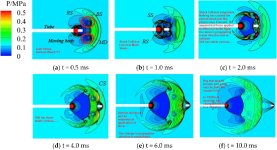When a barrel weapon launches a projectile, the muzzle flow field will cause initial disturbance to the projectile’s flight, reducing its shooting accuracy and increasing its impact point dispersion."
No, that is your morphing what they are looking for into your own desires.
This is exactly what they were investigating.
Large-caliber and long-barrel weapons are important experimental devices for exploring the impact resistance and reliability of warheads. The force of impact of the muzzle jet has a significant influence on the overload resistance of the warhead and surrounding devices. The mechanism of motion of the body inside the tube cannot be ignored owing to the high kinetic energy at the muzzle.
For some reason, you seem to have drawn a conclusion in absence of the any investigation. They did the investigation and came to a very different conclusion from you.
It contains data collected from an actual firing.
And? That has nothing to do with the fact they built a mathematical model to simulate that firing and you are confusing a simplified model to clarify the flow field.....with reality.
You are using the example that they removed the effects of the initial jet.
What it does your report conclude about using the simplified model without the effects of the initial jet:
If the distance to the muzzle is not considered under the operating conditions considered here, the muzzle jet without the initial jet-induced interference can be used as a simplified model for calculation beyond a distance of 5 m. [/B]
Under specific parameters, the simplified model you are quoting only works at distances away from the muzzle....
Anything other than that the simplified calculations can be used only IF:
When considering a location close to the muzzle and ignoring the moving body, the muzzle jet under interference by the initial jet can be used as a simplified model for calculation.
IF you ignore the fact the bullet is making Normal Shock Waves....
Shock Waves which lead too:
The strong shock wave of the muzzle jet collided with the weak vortex of the initial jet, causing it to disappear and leading to the formation of a stable vortex of the muzzle jet in the flow field.
Please stop avoiding it and answer the questions I have asked.
Two questions you must have the correct answer too in order to understand what is going on.
1. What is the velocity of the air at the normal shock?
2. What is the velocity of the air immediately downstream of and behind the Normal Shock?
Your "ah-Ha, Gotcha Report" is useful for designing a crown or a muzzle brake for an artillery piece but it does not make the claims you think it does....
The report seeks to devise a mathematical model for the flow of the muzzle jet. However the report says little to nothing about the effects of that muzzle jet on the flight of a bullet and actually provides evidence that it The Sierra Engineers were correct.
End this debate, John....
Simply point out the math in your report that illustrates the behavior of the bullet when the muzzle jet strikes it.
Last edited:




